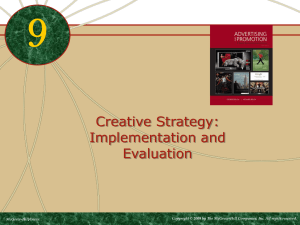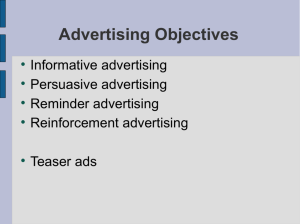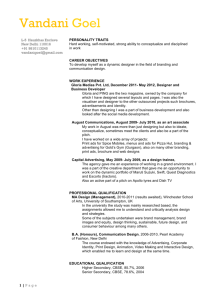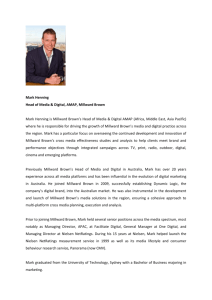Millward Brown - Emotion in Advertising: Pervasive, Yet
advertisement
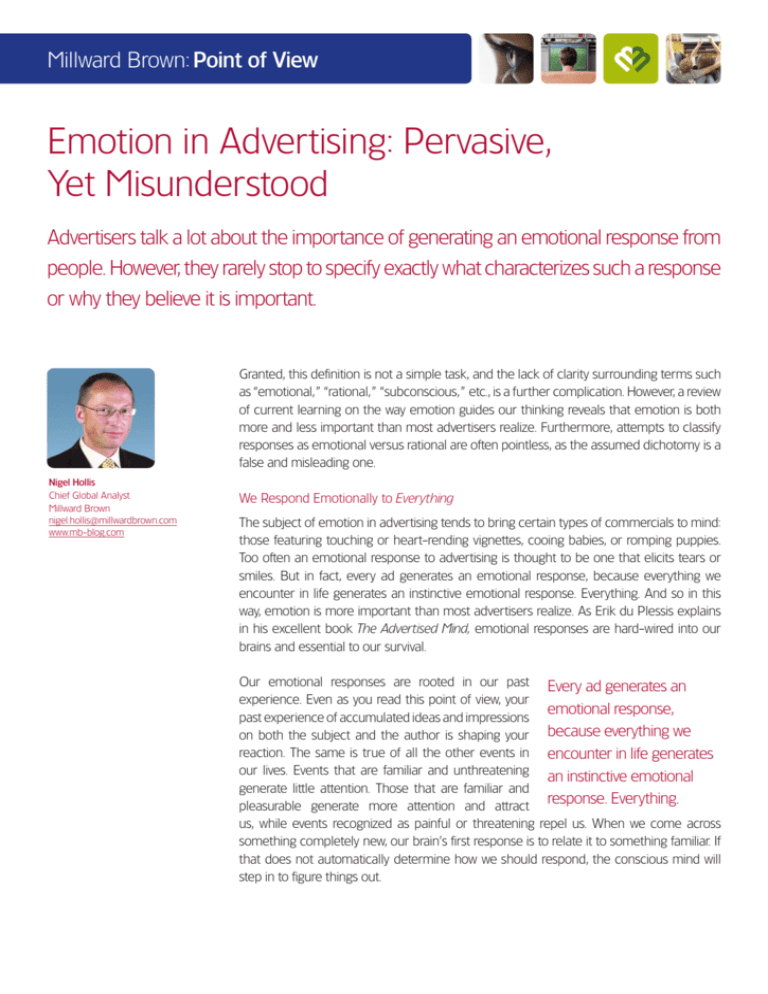
Millward Brown: Point of View Emotion in Advertising: Pervasive, Yet Misunderstood Advertisers talk a lot about the importance of generating an emotional response from people. However, they rarely stop to specify exactly what characterizes such a response or why they believe it is important. Granted, this definition is not a simple task, and the lack of clarity surrounding terms such as “emotional,” “rational,” “subconscious,” etc., is a further complication. However, a review of current learning on the way emotion guides our thinking reveals that emotion is both more and less important than most advertisers realize. Furthermore, attempts to classify responses as emotional versus rational are often pointless, as the assumed dichotomy is a false and misleading one. Nigel Hollis Chief Global Analyst Millward Brown nigel.hollis@millwardbrown.com www.mb-blog.com We Respond Emotionally to Everything The subject of emotion in advertising tends to bring certain types of commercials to mind: those featuring touching or heart-rending vignettes, cooing babies, or romping puppies. Too often an emotional response to advertising is thought to be one that elicits tears or smiles. But in fact, every ad generates an emotional response, because everything we encounter in life generates an instinctive emotional response. Everything. And so in this way, emotion is more important than most advertisers realize. As Erik du Plessis explains in his excellent book The Advertised Mind, emotional responses are hard-wired into our brains and essential to our survival. Our emotional responses are rooted in our past Every ad generates an experience. Even as you read this point of view, your emotional response, past experience of accumulated ideas and impressions on both the subject and the author is shaping your because everything we reaction. The same is true of all the other events in encounter in life generates our lives. Events that are familiar and unthreatening an instinctive emotional generate little attention. Those that are familiar and response. Everything. pleasurable generate more attention and attract us, while events recognized as painful or threatening repel us. When we come across something completely new, our brain’s first response is to relate it to something familiar. If that does not automatically determine how we should respond, the conscious mind will step in to figure things out. Millward Brown: Point of View Emotion in Advertising: Pervasive, Yet Misunderstood 2 a lasting memory is more likely to be created. The stronger the emotional charge, the more likely we are to consciously reflect on the experience at the time it occurs, and the more memorable the event will be. Even when the impression left by an ad is emotionally charged, repetition of the experience may be necessary to establish that impression in long-term memory. The less emotional the charge, the more repetition will be required. Attention on Gaining Attention Is Misplaced This initial instinctive “emotional” response determines three things: how much attention we will pay to the event that triggered it, what our conscious response will be, and how deeply our memories of the event will be entrenched. The response can be positive or negative, intense or weak. Most events, including those concerning brands and advertising, do not evoke an intense response. But even though our response may not be intensely positive or intensely negative, it is still “emotional.” Though audience attention is essential, attention alone is not sufficient. Too many ads attract a lot of attention that is focused neither on the brand nor the impression meant to be conveyed. Such ads are byproducts of the unwarranted belief that it is very difficult to gain people’s attention. In fact, it does not take a lot to make people attend to advertising. Anything that people find enjoyable, interesting, or noteworthy will be a cue to which they will readily respond and give some attention. This could be an interesting image, a story, music, or the brand itself. The real challenge is to focus people’s attention. If an ad is going to evoke a response that will last longer than a few seconds, it must create a memorable feeling. It must create a virtual magnifying glass that highlights something specific in relation to the brand — some fact, idea, or impression — and give it enough emotional charge to become established in memory. Transient Attention is Not The Same as Lasting Memory Emotional versus Rational: A False Dichotomy Emotion directs attention. Instinctive emotional responses can make people notice brands and advertising. But the emotional response alone is not enough because transient attention is not the same as a lasting memory. And marketing’s role is to create, shape, and reinforce memories that will motivate consumers to behave in a certain way — for example, to try a brand, to be willing to pay a premium for it, or to remain loyal to it over time. Advertisers often make a distinction between emotional and rational advertising. But in reality, this distinction between emotional and rational is one that exists only in the minds of marketers, not consumers. In his book The Feeling of What Happens, the eminent cognitive scientist Antonio Damasio writes, “Consciousness must be present if feelings are to influence the subject having them beyond the immediate here and now.” In other words, just because we attend to something once does not mean we are going to remember anything about it at a later date. But when facts, ideas, and impressions are emotionally charged, ©2010 Millward Brown Advertisers select a strategy in accordance with their specific advertising objectives; ultimately they want to generate sales. To this end, an advertiser may select a functional or pricerelated claim with the expectation that people will immediately and consciously recognize and appreciate the relevance of the message. This “rational” response is most often referred to as “persuasion.” Strong persuasion is typically the response to advertising that conveys something new, relevant, credible, and unique. Of course, what the marketer intends and how the consumer responds may be very different. What is new news to one person may be old news to another. Millward Brown: Point of View Emotion in Advertising: Pervasive, Yet Misunderstood Transient attention is not the same as a lasting memory. But when people respond positively to a message that is new, relevant, credible, and unique, are they being “unemotional”? In fact, Millward Brown research shows that high persuasion scores correlate with a positive emotional response. This suggests that the recognition of a newsworthy and relevant message can create a sense of appreciation, satisfaction, or even elation in the case of a longstanding or deeply felt need. 3 explicit factual messages, they seem to provide evidence that this “emotional” approach is more motivating and memorable to consumers. But that may not really be the case. Consider the Unilever campaign “Dirt Is Good. ” The ads in this highly successful and much-lauded campaign did not explicitly say that Persil (Omo) will get your kids’ clothes clean no matter what they get into. Nor did it reveal the brand’s cleaning power through a demonstration. Rather, it presented strong implicit communication that you can let your kids get dirty because you can trust Persil to do its job. But it is important to note that it is only because Persil spent many years establishing its Oftentimes advertisers steer away from the presentation of functional credentials with explicit claims like “Persil Washes factual claims and create ads that they hope will evoke an Whiter” that the brand can now communicate its functional “emotional” response. They want the ads to resonate with the message implicitly. target audience on some level; they want people to relate to the situation portrayed in the ad. They want viewers to come This leads to another important point that is often overlooked away from these ads feeling positive in some way: moved, in discussions of emotion in advertising: Product satisfaction rewarded, pleased, or proud, to name just a few responses. is the biggest driver of emotional response. If people did not Feelings such as these, which can be prolonged and which can believe that Persil cleaned effectively, the ads would not stir be the subject of conscious reflection, can have a significant feelings of parental love and pride, but rather resentment effect on our decision making. Analysis of Millward Brown’s and irritation. Not all brands have the “right” to communicate Link pretest database suggests that a positive emotional messages implicitly through emotionally arousing content; response to an ad is most strongly correlated with reported that is a privilege that is earned over time. Persil has earned increases in brand appeal. that right. So has Coca-Cola. Coke can create fanciful and fantastic ads in the “Happiness Factory” campaign because These types of emotional appeals can be very powerful. it has spent decades building a connection between Coke, And because the ads based on this approach appear to lack optimism, and joy in living. But newer brands still need to focus on establishing their functional credentials even when their ultimate intent is to “ladder up” to an emotional benefit. Some of the most successful advertising in the world succeeds because it focuses our attention on what matters most: a positive experience delivered by a product making good on its promise. Emotional response needs to be grounded in something that the brand is or does. Therefore, I would suggest that even the likes of Persil and Coca-Cola can ill afford to ignore their functional benefits, even if they do not need to state them explicitly. Emotional and Factual Appeals Work Together Emotional and factual appeals cannot be easily separated. Not only will any appeal generate some degree of emotional ©2010 Millward Brown Millward Brown: Point of View Emotion in Advertising: Pervasive, Yet Misunderstood 4 response, but a factual claim may be required to activate the If all advertising generates an emotional response of full power of the emotional response by helping people justify some sort, the real question then becomes whether their brand choices. an advertisement will evoke any conscious thought. My colleague Graham Page suggests that we humans are not so much rational as “rationalizers.” We want to believe that our choices are justified by reason, not just feelings. Though the “right” choice feels good, we need to help buyers tell themselves a story of rational choice. Except in the case of extremely well-known brands and categories, we may need to provide evidence that people will then use to justify their choice. Ultimately, findings from our research — both brand equity and pretesting — have shown that the most effective marketing presents both rational and emotional reasons to use a brand. Unfortunately, many pundits muddy the waters by equating conscious thought with a “rational” response. We are, however, conscious of both thoughts and feelings. And how consumers respond to different types of communication will always start with how they instinctively feel about them. So if all advertising generates an emotional response of some sort, the real question then becomes whether an advertisement will evoke any conscious thought beyond some recognition of how it made one feel. Conclusion Emotion is at work all through the process of reacting to advertising: from our initial response to our feelings about the brand to the interest and faith we have in the claims and appeals of the advertising. Advertisers would do well to clarify why emotion is important in their advertising. Are we seeking to use emotion to gain and hold attention or to create a longer-lasting response related to the brand? And what lasting impression will be of most benefit? Will a positive feeling suffice, even if it is difficult to articulate or justify, or is a defined rationale required? Will the experience or rationale be compelling and distinctive enough to make people want to talk about it with others? Irrespective of the desired response to advertising, the first step is to create a link in consumers’ minds between the memories left by the ad and the brand. To do so an ad must focus attention on the brand and the desired impression at the time of viewing. If that happens, the memories left will be readily available for introspection when people think about the brand, and the ad will have the potential to affect behavior weeks, months, and even years later. If that link is not set up, the investment in content development and media spend will have been wasted. To read more about emotion and advertising, visit our blog at www.mb-blog.com. If you liked “Emotion in Advertising: Pervasive, Yet Misunderstood,” you might also be interested in: The Advertised Mind Neuroscience: A New Perspective Engaging Consumers’ Brains: The Latest Learning Share this POV: ©2010 Millward Brown





